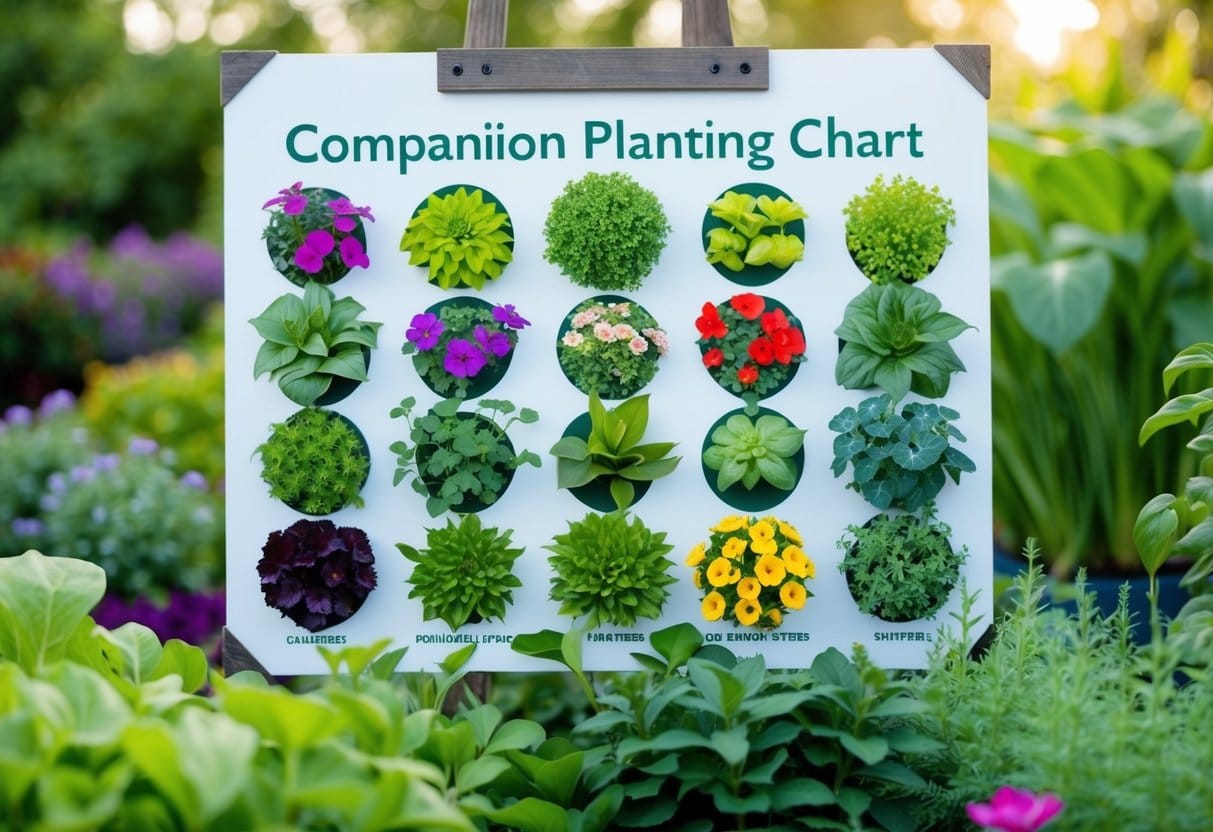Companion planting is a gardening strategy that involves growing different plants together to support each other. This method is particularly popular in vegetable gardens, though it can also enhance the health of ornamental plants like roses. The concept is grounded in both practical experience and traditional knowledge.
While scientific evidence may be limited, many gardeners have found success through trial and observation.
Understanding the relationships between plants can lead to better gardening outcomes. By recognizing how various species interact, gardeners are able to make informed decisions about what to plant together. This knowledge not only helps in maximizing yields but can also contribute to a healthier garden ecosystem.
As one explores the benefits and best practices of companion planting, they will discover useful charts and tips tailored for various crops and their unique needs.
Key Takeaways
- Companion planting enhances the growth and health of plants by pairing compatible species.
- Observations and historical gardening lore play a significant role in effective planting strategies.
- Understanding plant relationships can improve the yield and health of a vegetable garden.
Companion Planting Chart
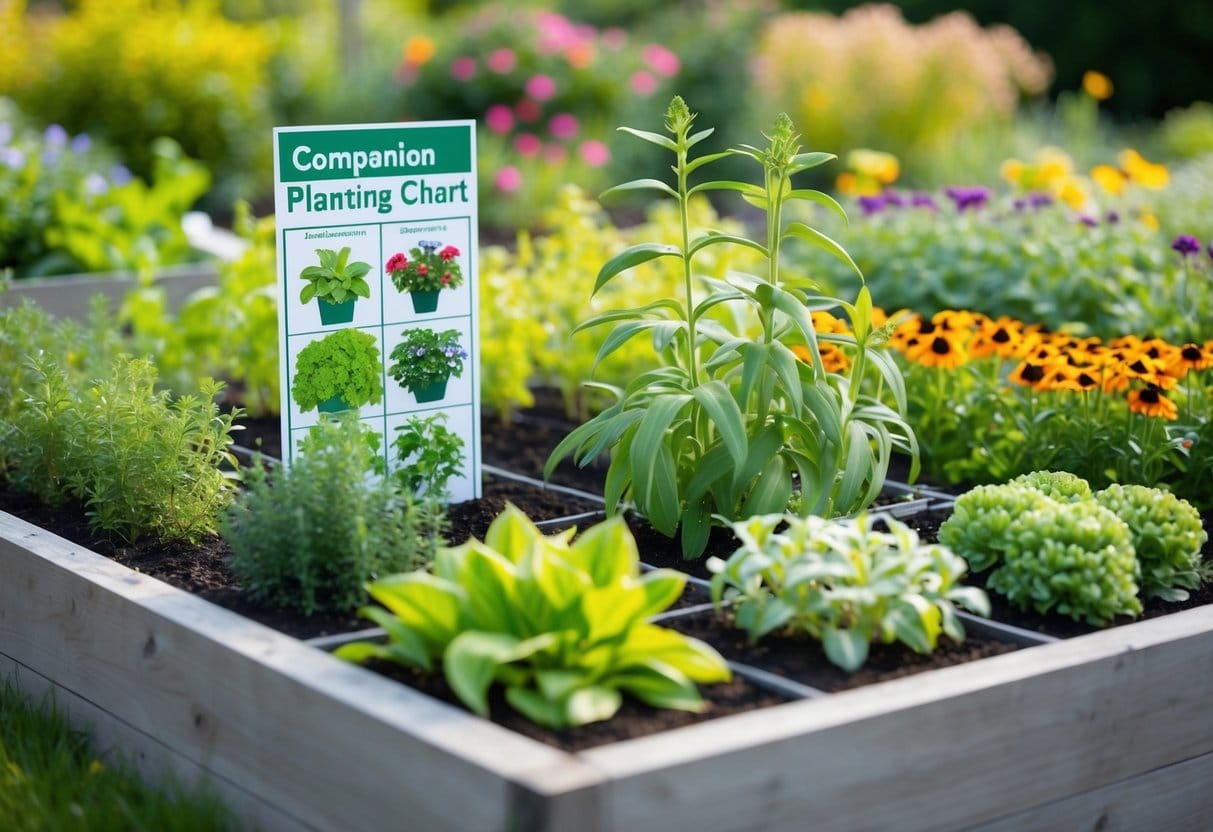
Companion planting can enhance a garden by supporting plant growth and reducing pests. It is crucial to follow crop rotation guidelines and avoid planting the same vegetable in the same location across consecutive years to prevent disease and nutrient problems.
Here is a companion planting chart that lists popular garden crops along with their suggested companion plants:
| Garden Crop | Recommended Companion Plants |
|---|---|
| Asparagus | Calendula, Petunias, Tomatoes |
| Basil | Peppers, Purslane, Tomatoes |
| Beans | Broccoli, Cabbage, Carrots, Cauliflower, Corn, Cucumbers, Eggplants, Garden Peas, Potatoes, Radishes, Squash, Strawberries, Tomatoes |
| Beets | Brassicas, Bush Beans, Garlic, Lettuce, Onions |
| Broccoli | Oregano, other Brassicas (cabbage, Brussels sprouts, cauliflower) |
| Brussels Sprouts | Basil, Beans, Beets, Carrots, Garlic, Mint, Nasturtium, Onions, Peas, Thyme |
| Cabbage | Other cole crops (broccoli, Brussels sprouts, collard greens, kale), Onions, Potatoes |
| Carrots | Chives, Leeks, Onions, Peas, Radishes, Rosemary, Sage |
| Cauliflower | Beans, Beets, Broccoli, Brussels Sprouts, Celery, Corn, Onions, Radishes, Spinach, Cucumbers |
| Corn | Beans, Cucumbers, Garden Peas, Melons, Potatoes, Squash |
| Cucumbers | Beans, Beets, Corn, Onions, Garden Peas, Radishes |
| Dill | Broccoli, Brussels Sprouts, Cabbage, Corn, Cucumbers, Lettuce, Onions |
| Eggplant | Beans, Catnip, Marigolds, Peas, Peppers |
| Garlic | Beets, Carrots, Cole crops, Eggplant, Peppers, Potatoes, Tomatoes |
| Kale | Beets, Beans, Celery, Cucumbers, Dill, Garlic, Lettuce, Mint, Onions, Peas, Peppers, Potatoes, Rosemary, Sage, Spinach |
| Lettuce | Corn, Pumpkins, Radishes, Squash |
| Onions | Beets, Carrots, Cole crops, Lettuce |
| Peas | Beans, Carrots, Corn, Cucumbers, Eggplant, Peppers, Radishes, Spinach, Tomatoes |
| Peppers | Basil, Onions, Okra |
| Potatoes | Beans, Cole crops, Corn, Lettuce, Spinach, Radishes |
| Radishes | Chervil, Lettuce, Nasturtium, Peas |
| Rosemary | Beans, Broccoli, Brussels Sprouts, Cabbage, Carrots, Cauliflower, Kale |
| Spinach | Beans, Cilantro, Eggplant, Oregano, Peas, Rosemary, Strawberries |
| Strawberries | Borage, Bush Beans, Caraway, Chives, Lettuce, Onions, Sage, Spinach, Squash |
| Tomatoes | Basil (and other herbs), Carrots, Cucumbers, Squash |
| Watermelon | Broccoli, Corn, Garlic, Radishes |
| Winter Squash | Beans (pole), Buckwheat, Calendula, Corn, Marigolds, Nasturtium, Oregano |
| Zucchini | Beans, Corn, Garden Peas, Radishes |
Using these companion plant pairings can result in a healthier and more productive garden.
Advantages of Plant Partnerships
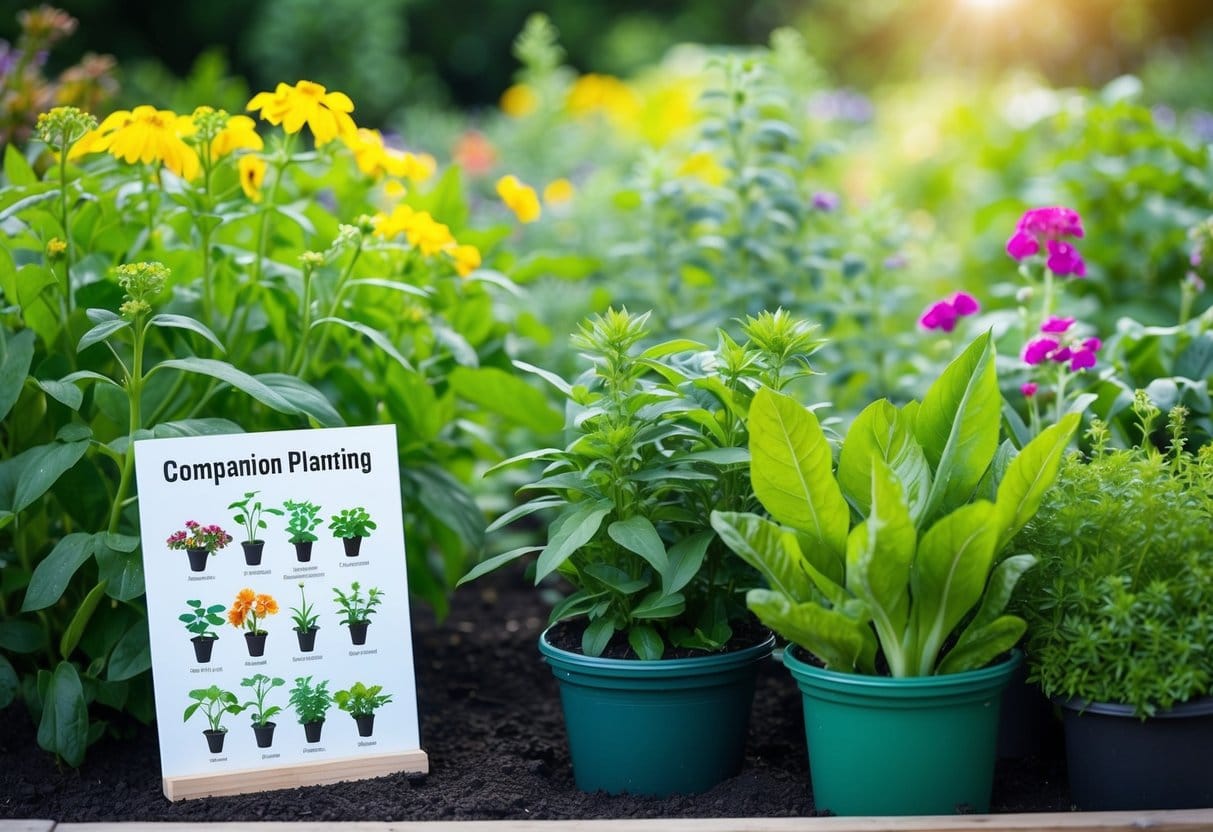
Companion planting offers a variety of benefits for gardeners. The right combination of plants can attract helpful insects, such as pollinators, while keeping harmful pests at bay. Certain plants naturally repel unwanted visitors, like raccoons, which tend to avoid cucumbers due to their scent.
In addition to pest control, these plant partnerships can enhance soil health. They improve the availability and uptake of nutrients.
For instance, tall crops like corn can provide much-needed shade for more delicate plants like lettuce during the summer months. They also serve as natural supports for vines and other trellising plants.
Mixing different crops can help delineate garden rows and distinguish quick-germinating seeds, such as radishes, from slower ones like lettuce. Effective companion planting can also aid in weed suppression, making garden maintenance easier.
Guidance
To maximize benefits, it is advisable to plant companion species as close to one another as possible without violating their spacing needs. Seed packets and care guides typically indicate ideal spacing. Some plants may thrive at 6-inch separations, while others require 12 inches.
In such cases, a compromise of around 9 inches can often work well to ensure both plants flourish.
Best Companion Plants
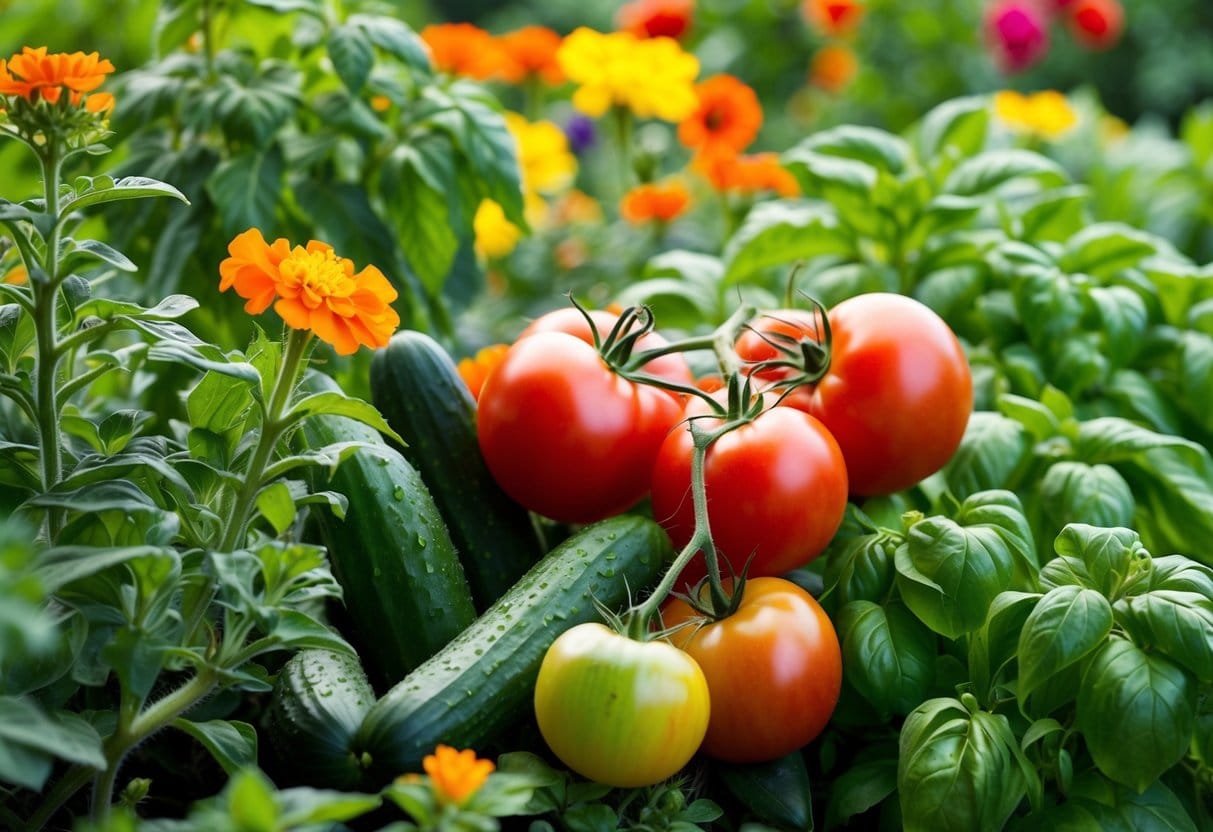
Certain vegetable pairings thrive together, enhancing growth and reducing pests. Here are some of the best combinations:
- Corn, Pole Beans, and Squash: Referred to as the “three sisters,” this classic trio supports each other well. The tall corn provides a climbing structure for the pole beans, which in turn enrich the soil with nitrogen. Squash, with its broad leaves, protects the soil by conserving moisture and slowing weed growth.
- Cucumbers, Sunflowers, and Pole Beans: Like the three sisters, this group works together efficiently. Sunflowers stand tall and offer support to climbing pole beans, while the cucumber vines provide ground cover.
- Basil and Tomatoes: These plants are natural allies. Basil helps to deter pests like thrips and disrupt the behavior of moths that attack tomato plants.
- Sage with Carrots or Cabbage: Sage acts as a barrier against carrot flies and cabbage moths, protecting these vegetables from damage.
- Parsley and Tomatoes: Parsley attracts helpful insects that prey on harmful pests affecting tomatoes.
Some plants can enhance the growth of nearly any companion through pest control. These are:
- Nasturtiums: This plant draws caterpillars away from cruciferous vegetables like cabbage, broccoli, and kale.
- Mint: Known for its strong aroma, mint effectively repels pests such as aphids, ants, and flea beetles.
- Garlic: A strong-scented relative of onions, garlic deters aphids and various beetles, making it valuable in the garden.
- Dill: This herb attracts ladybugs, which help manage destructive aphid and spider mite populations.
Companion Planting with Herbs
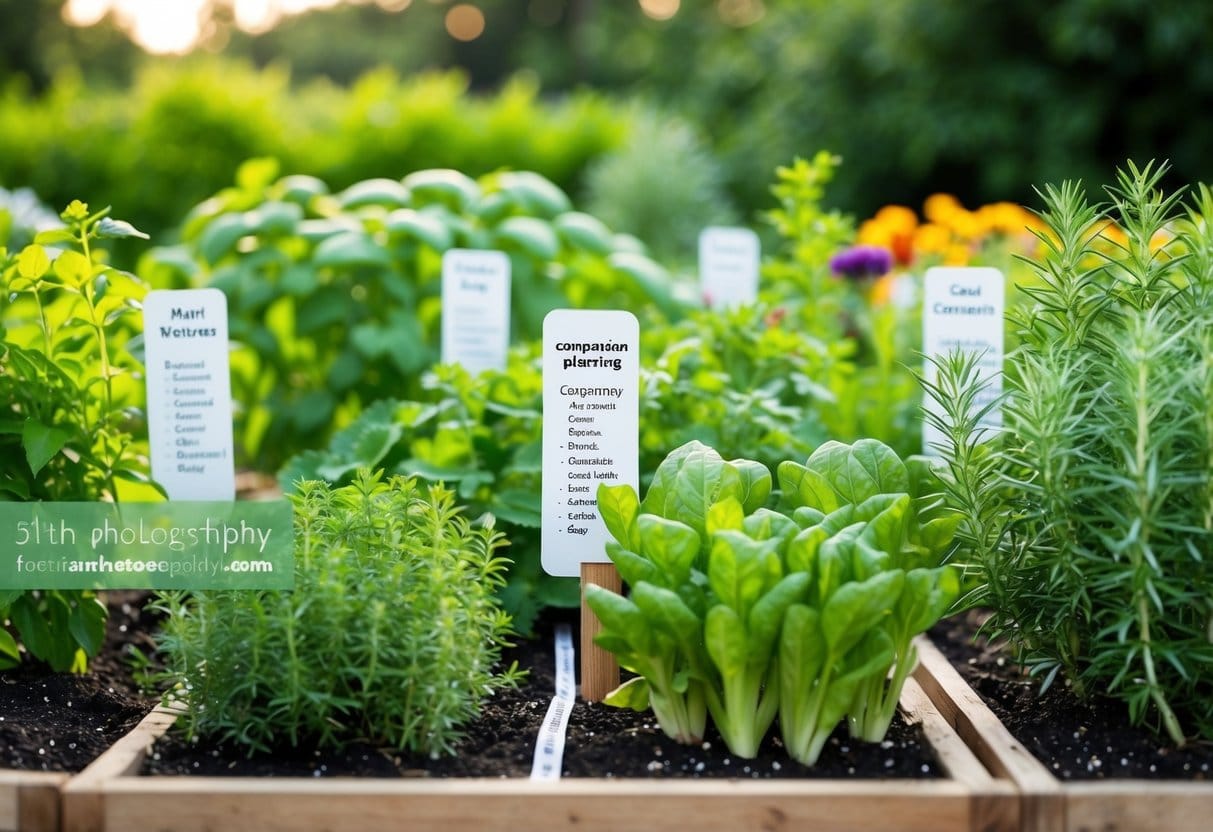
Growing herbs in a garden offers many advantages. They can help manage pests and attract important insects, enhancing biodiversity. Several culinary herbs serve these purposes effectively:
- Basil: Deters pests like aphids and tomato hornworms.
- Chives: Protects nearby plants while adding flavor.
- Cilantro (Coriander): Attracts beneficial insects close to vegetables.
- Lavender: Repels unwanted pests and draws pollinators.
- Mint: Works as a pest repellent while providing culinary uses.
- Rosemary, Sage, Thyme: Useful for enhancing flavors and managing pests.
Blooming herbs are especially effective at attracting critical beneficial insects, making them valuable allies in any garden.
Flowers as Companion Plants
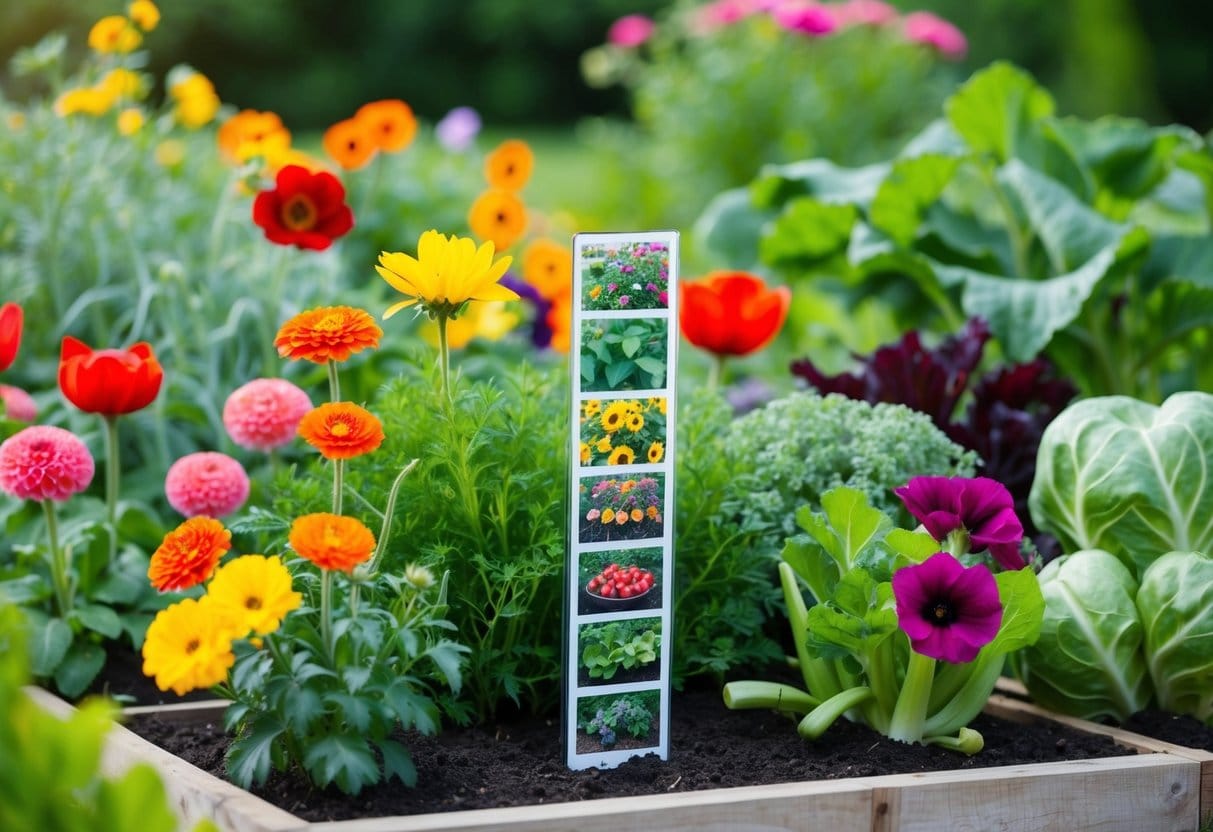
Flowers as a Beacon for Pollinators
In a vegetable garden, flowers serve not only as decoration but also play a crucial role in attracting important pollinators. Bees and other insects are vital for transferring pollen, which assists vegetable plants in growing and producing fruits.
Popular choices that attract these pollinators include zinnias, sweet alyssum, daisies, sunflowers, and cosmos. By incorporating these flowers, gardeners can enhance the health and yield of their vegetable crops.
Flowers as Deterrent for Problem Pests
Certain flowers have properties that help repel harmful pests.
For example, marigolds are known to discourage cabbage worms, which target vegetables like cabbage, broccoli, and kale. Similarly, petunias can deter squash bugs and tomato hornworms, making them great companions for crops such as beans and tomatoes.
Additionally, ornamental alliums, such as onions and chives, are effective at keeping away deer, rabbits, and various insects, including carrot flies and potato beetles.
How and When to Plant Companion Flowers
To maximize the benefits of companion planting, it is essential to split flowers into groups that bloom concurrently with the intended vegetables.
Many gardening guides or seed packets provide bloom times, which can assist in planning.
It’s also important to consider the watering and sunlight needs of each plant.
Placing taller plants like tomatoes behind shorter flowers such as marigolds allows for optimum sun exposure for both types.
By matching plants with similar growing conditions, they can be strategically interspersed in rows or arranged in borders. This arrangement not only promotes healthy growth but also creates an appealing visual layout in the garden.
Which Vegetables Shouldn’t Be Planted Together

In gardening, some plants do not thrive in close proximity to others. Certain vegetables compete for nutrients, water, and space, making them poor companions.
Problematic Pairings:
- Tomatoes and Corn: Both of these plants have high nutrient and water demands. Additionally, corn can overshadow tomatoes, stunting their growth.
- Zucchini and Lettuce: The rapid growth of zucchini can easily overtake lettuce, depriving it of necessary sunlight and space.
- Fennel: This plant often disrupts the growth of nearby crops. It is best to plant fennel away from other vegetables.
- Beans and Alliums: Beans should not be planted near onions or garlic. The presence of alliums can hinder the germination of beans.
Disease and Pest Concerns:
Plants that attract similar pests or are susceptible to the same diseases should also be kept apart.
For example, cruciferous vegetables like cauliflower and kale attract pests such as aphids and cabbage loopers. These should be placed at opposite ends of a garden to minimize the risk of infestations and disease spread.
Considerations for Asparagus and Potatoes:
Asparagus does not pair well with potatoes. Planting these two together can hinder the growth of each. Keeping these crops apart ensures they can flourish without competition.
Frequently Asked Questions

Which plants are good companions for tomatoes in the garden?
Tomatoes grow well with several companion plants that can help improve their health and growth. Some of the best companions for tomatoes include:
- Basil: Enhances flavor and repels pests.
- Marigolds: Deters harmful insects.
- Carrots: Can help break up the soil below.
- Garlic: Acts as a natural pest repellent.
How does companion planting boost vegetable garden yield?
Companion planting can improve garden yields in several ways:
- Pest Control: Certain plants can repel insects, reducing damage.
- Soil Health: Some plants can improve soil nutrients.
- Space Optimization: Different plants can use space and sunlight efficiently.
- Pollination: Attracts beneficial insects that help with pollination.
Can you explain companion planting and its benefits?
Companion planting is the practice of growing different plants close to each other for mutual benefits. Benefits include:
- Natural Pest Management: Reduces the need for chemical pesticides.
- Improved Growth: Certain combinations enhance growth rates.
- Flavor Enhancement: Some plants improve the taste of others.
What are some common combinations in companion planting for a vegetable garden?
Here are some popular companion planting pairings:
- Beans and Corn: Beans fix nitrogen in the soil while corn provides support.
- Cucumbers and Radishes: Radishes can deter cucumber beetles.
- Lettuce and Carrots: They share space well and don’t compete for resources.
Are there any plants that should not be planted together?
Certain plants can negatively affect each other when planted together, such as:
- Tomatoes and Potatoes: Both are prone to similar pests and diseases.
- Onions and Peas: Onions can inhibit the growth of peas.
- Cabbage and Strawberries: Cabbage can stunt the growth of strawberries.
What is the ‘rule of three’ in companion planting and how is it applied?
The ‘rule of three’ suggests planting in groups of three different species to create a balanced ecosystem.
This approach helps:
- Enhance Biodiversity: Encourages a diverse range of plants.
- Mutual Benefits: Each plant can help the others thrive.
- Resource Sharing: Plants can utilize nutrients and space more efficiently.

